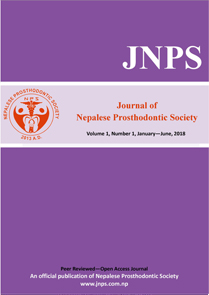Surface Modification of Titanium Dental Implants: A Review
DOI:
https://doi.org/10.3126/jnprossoc.v1i1.23849Keywords:
Dental Implants, Osseointegration, WettabilityAbstract
Osseointegration of titanium dental implants is the most important clinical parameter for an implant to be successful. One of most biocompatible material, titanium can be made to affix fast on to host bone via various modification of its surface. Machined and smooth titanium implant osseointegrate into living bone tissue but with a roughened surface, this is much more predictable as well as promising clinically. Surface modification allows for an increase in the surface area on to which the osteoblasts easily start laying bone. So, there have been various methods to roughen the surface of titanium implants. The article describes various methods used for modifying the surfaces of dental implants, giving a note on their clinical efficacy as well as advantages and disadvantages of these methods.
Downloads
Downloads
Published
How to Cite
Issue
Section
License
This license enables reusers to distribute, remix, adapt, and build upon the material in any medium or format, so long as attribution is given to the creator. The license allows for commercial use. © The authors




